 |
||
|
||
| ||
If you read the videocard ASUS AGP-V7700/64 reviews which feature is the availability of 64 MBytes local video memory, you certainly still remember the summary - similar cards price is too high and the twice greater video memory size doesn't give a lot in real games. Only the operation with applications using huge size operating texture can somehow warrant expenses on cards of 64 MBytes local video memory. Memory is rather fast (DDR SDRAM), however its resulting rate 333 MHz is not enough for such powerful geometry processor as NVIDIA GeForce2 GTS. Nevertheless in the market there are new accelerators of 64 MBytes local video memory and so it is worth discussing. The company Innovision Multimedia is widely known in the market of videocards as the supplier of very inexpensive products. It is caused by the fact that mostly the cheapest videocards under the trade mark Innovision Multimedia are transported to some countries. In result some users suppose that Innovision Multimedia it something noname made in China, and so this production is of rather bad quality. And really a number of this corporation models have very low quality in 2D-graphics. Before the issue of cards on GeForce 256/GeForce2 chips practically all manufacturers changed the videocards design by their own way that occasionally worsened the card operation quality. What's more very cheap components of bad quality were used for wiring on cards. A part of users began to name almost all noname videocards by the name "innovision". It was often possible to hear the phrases like this, "You'd better purchase ASUS or Creative or you can get some innovision..." Certainly it sounds rather offensive for the corporation though sometimes it is deserved. It is not a secret that to earn a name arousing the buyers confidence is much more difficult than to earn the cheap manufacturer reputation. Taking into account the fact that the majority of cards on the basis NVIDIA GeForce 256/GeForce2 are fulfilled on the basis of reference design, and it is possible to assume that the videocards from Innovision Multimedia on these GPU at last can change the image of the company among the Russian users. Therefore as soon as possible I decided to test one of the latest novelties from the corporation Innovision Multimedia - videocard on the basis NVIDIA GeForce2 GTS. Already during the first videocards on the basis GeForce 2 GTS announcement many manufacturers have declared about the possible release of 64-MByte cards variants. Unconditionally the main deterrent factor of such cards appearance in the market is their price and also many manufacturers fear that such cards won't be sold. As a result the cards with 64 MBytes local video memory are produced by rather insignificant print run. The availability of 64 MBytes video memory for cards on the basis GeForce2 GTS can be demanded only by applications where textures of huge size are operated or at operation with applications in superhigh resolutions. Practically there are no game applications related to the first case and as for the second case in superhigh resolutions the level of games is very low. By the way again because of the bus transmission capacity shortage we return to the conclusion that for the class GeForce2 GTS cards the installation of faster memory is more important than the memory size increase. Nevertheless videocards on the basis GeForce2 GTS of 64 MBytes local video memory appear on the market. The prices are not low. By the way about the prices: one more reason why I have become interested in the videocard from Innovison is a rather low cost of 64-MByte version of the card on NVIDIA GeForce2 GTS which is capable to compete on the price with usual 32 MBytes cards. Let's look attentively at Inno3D Tornado GeForce2 GTS/64. CardInno3D Tornado GeForce2 GTS/64 basic characteristics
We shall not describe in detail GPU GeForce2 GTS from NVIDIA features and possibilities because you can always find all the necessary data in this article. Let's look now at card: The card has AGP2x/4x interface, 64 MBytes 6 ns DDR SDRAM of memory placed in 8 chips posed on the face PCB: 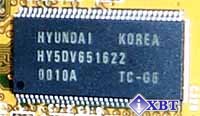 The memory chips are produced by the corporation Hyundai and planned for operating rate 166 MHz. Memory functions on this rate. I'd like to note that the resulting values of DDR memory clock rate which are twice more and look more impressively are given though it doesn't change the essence. That is if it is said that DDR-memory operation rate is 333 MHz, actually it works on the rate 166 MHz. I am not fully satisfied with video memory operation speed. On the example ATI RADEON 64 MBytes we already could be convinced that faster than 166 MHz memory exists (for example 183 MHz or even 200 MHz). And it is absolutely not clear why NVIDIA still delivers GPU GeForce2 GTS to the videocards manufacturers in the completion with less high-speed memory chips. Probably it was purchased too many 166 MHz. On the given card there is a usual active cooler which we can see on lots of videocards. The ventilator on the given cooler is placed on the flat heat sink and blows the warm air away apart. It is easy to note that Innovision used the reference design for the card manufacture. The card is deep yellow. On PCB there are some plugs for the daughter card wiring from TV-out (the card itself is not present). There is also the empty place for the plug installation to connect digital screen monitors. The videocard is delivered in the box of bright design: 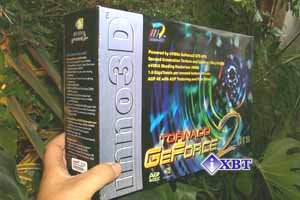 In a box you can find not only the user's guide, CD - disk with drivers and utilities, but also some more disks:
Moreover the complete version MadOnion 3D Mark2000 Pro. is delivered on the CD - disk with drivers and utilities. You can also find two blocks of paper for notes with the firm trade mark. I can't help praising the company for such excellent delivery! OverclockingThe practice shows that video memory from Hyundai usage usually promotes good possibilities for overclocking. The practice has completely confirmed it. On the given card we managed to disperse the chip up to the rate 220 MHz, and the memory was forced to work on the resulting rate up to 400 MHz. At the moment such overclocking is the third result after ASUS AGP-V7700 (32 MBytes) and ASUS AGP-V7700/64. Therefore we should expect significant increase in productivity at this card operation on high rates. Especially memory overclocking should effect the productivity. As I have already marked in the previous materials the installation of relatively slow memory with the resulting clock rate 333 MHz on the card with the so productive geometry processor makes the videocard unbalanced in whole. The similar situation was noticed with cards on the basis NVIDIA GeForce256 with the installed local video memory such as SDR SDRAM. Installation and driversNow here is the practical part of our review. For the beginning I shall present the test desks configuration: The bench on the basis Pentium III:
The screen monitor ViewSonic P810 (21") was used on the bench. The corporation Innovision Multimedia delivers reference drivers from NVIDIA version 5.22 with the videocard, therefore I won't examine them in detail. Everybody can acquaint himself with the customisation description in our reviews. I shall only mark that the version 5.33 beta from NVIDIA drivers were used for testing. Results of the testsWe shall start with 2D-graphics. In the previous materials I marked excellent quality and rather big speed in 2D-graphics which were demonstrated by cards on the basis GeForce2 GTS from NVIDIA. I have already noticed rather bad quality of lots of cards from the corporation Innovision Multimedia. And now I can state with pleasure that all the indexes of the card Inno3D Tornado GeForce2 GTS/64 in 2D are not worse than for other cards of this class (the complete repetition of the standard design from NVIDIA effects). I can state that Inno3D Tornado GeForce2 GTS/64 together with the rest of the cards on the basis GeForce2 GTS will provide the needs for qualitative image. Now 2D-graphics quality of videocards on the basis GeForce2 GTS has grown relatively to NVIDIA GeForce256, and the ownes of the good 21-inch screen monitors will be pleased. It is also related to the screen monitors with a smaller diagonal. We shall examine high-speed indexes of Inno3D Tornado GeForce2 GTS/64 in 3D-graphics using two games:
These instruments are quite enough to show the videocard productivity at operation through two main API. For visualisation the speed indexes of two videocards are shown on the diagram: ATI RADEON 64 MBytes VIVO and ASUS AGP-V7700/64 on the basis GeForce2 GTS (in some tests 32 MBytes videocard ASUS AGP-V7700 was also participated). Besides we shall show how the productivity of the videocard Inno3D Tornado GeForce2 GTS/64 has change in the overclocked mode. 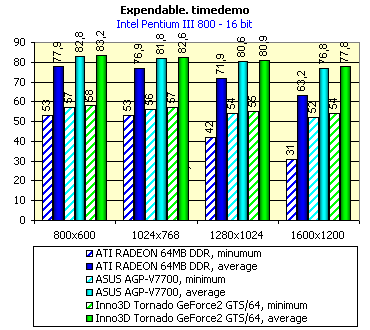 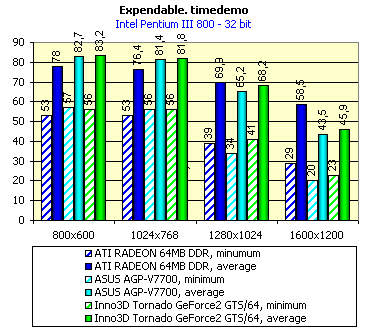  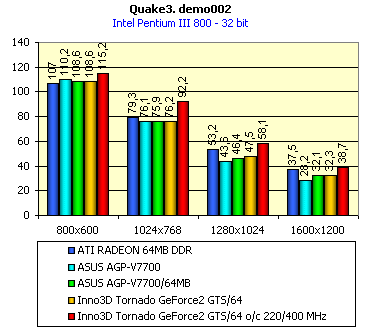 It is easy to note that the productivity index of the videocard Inno3D Tornado GeForce2 GTS/64 practically do not differ from the results of the similar card ASUS AGP-V7700/64 and also 32-MBytes card ASUS AGP-V7700 anticipating a little the last one only in the high resolutions. ATI RADEON 64 MBytes VIVO indexes in 32-bit colour have remained inaccessible. This proves that it is more important to use faster memory than to increase memory size. But the overclocking of the tested example has shown what else the chip GeForce2 GTS ñan give at faster memory installation. The fact that the graphics core was also dispersed effected the result unessentially. The main increase of productivity is provided by memory which stably worked on the rate 200 (400) MHz. I'd like to mark that the card from Innovision Multimedia worked at minimum external additional cooling (only one additional ventilator was placed in the system block for good air circulation). Certainly I can not extrapolate the results of the given card overclocking on all cards on the basis GeForce2 GTS, however we can hope that the overclocking fans can select the suitable copy. As we see at probing in games where 32-MBytes cards use their memory size and also use the possibilities of AGP-texturing the 64-MBytes card installation gives a little. It is possible to consider that it gives practically nothing. However as we were already convinced on the example ASUS AGP-V7700/64, if to look at the card operation in Quake3 at the level q3dm9 where there are a lot of large textures, we see another situation (at testing all installations were on maximum - both the geometry level and the level of detailing textures). I shall just remind that in 32-bit colour when the sizes of textures run through the video memory exceed the local memory size in 32 MBytes, the availability of 64 MBytes is the advantage of the videocard. On the diagrams given below it is visible that Inno3D Tornado GeForce2 GTS/64 goes practically the same way as ASUS AGP-V7700/64 completely confirming the summary of this review on the previous card. 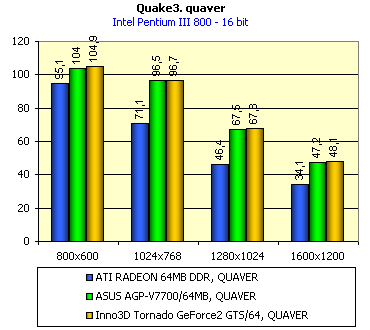 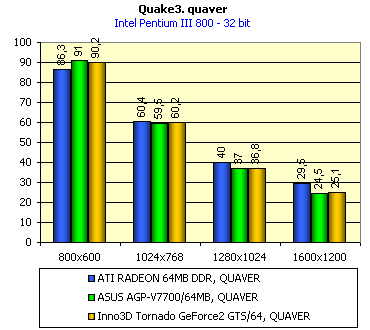 Let's note that Inno3D Tornado GeForce2 GTS/64 is very close on rate to ATI RADEON 64 MBytes VIVO though it doesn't pass it. These results are rather significant for the cases of usage similar videocards with software products operating large sizes textural material or with very complex multipolygon objects. Practically there are no such games except some scenes in Quake3-similar games or demo-programs. Additional possibilitiesAs for playing DVD-Video everything is all right. The player InterVideoWinDVD 2000 delivered with the videocard, InterVideo WinDVD 2000 was installed without any problems, the quality of the image was excellent, load processor percent was not more than 30%. SummarySo the card Inno3D Tornado GeForce2 GTS/64 is the first representative of cards from the corporation Innovision Multimedia on the basis NVIDIA GeForce2 GTS, having the impressive video memory size. As we have clarified this card is just as good as the competitors by rate. In spite of the fact that its productivity in most cases is at the level of 32-MByte card, the board costs a bit more or nearly so as the cards on the basis GeForce2 GTS with 32 MBytes local video memory ($290 at the beginning of August). If on the example of ASUS AGP-V7700/64 it is possible to say that the difference in price between this card and 32-MBytes ASUS AGP-V7700 is not fair, the conclusion in this case is completely another. A lot of professional applications where this board can show itself like the famous and much more expensive cards are out of our examining. As for games the possibility to use so large size of local video memory is very poor because the memory leaves much to be desired. I'd like to mark that the card Inno3D Tornado GeForce2 GTS/64 has the large possibilities for overclocking and I have to stress once again that overclocking capabilities of videocards depends on the concrete copy. Taking into account all said above and the fact of availability high-quality 2D-graphics I can recommend the card Inno3D Tornado GeForce2 GTS/64 to so-called Hardcore Gamers-the users very much keen on modern, superdemanding to graphics accelerators games. The card will suit also those users who love to purchase all newest, high-speed and modern for games with the large store on future, as the given videocard can provide both good high-speed metrics and graphics quality for a long time. Pluses:
Minuses:
Write a comment below. No registration needed!
|
Platform · Video · Multimedia · Mobile · Other || About us & Privacy policy · Twitter · Facebook Copyright © Byrds Research & Publishing, Ltd., 1997–2011. All rights reserved. |